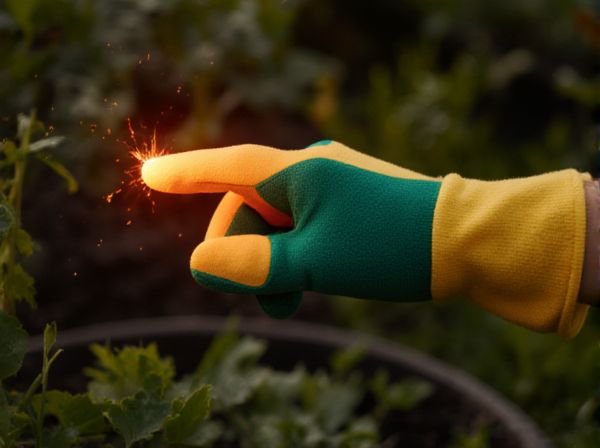
Sun scorch vs etiolation Illustration
Sun scorch occurs when excessive sunlight damages plant leaves, causing browning and tissue death, while etiolation results from insufficient light, leading to pale, elongated stems as the plant stretches toward a light source. Both conditions negatively affect plant health but stem from opposing light exposure issues. Proper light management prevents sun scorch by avoiding intense direct sun and stops etiolation by providing adequate illumination.
Table of Comparison
| Aspect | Sun Scorch | Etiolation |
|---|---|---|
| Cause | Excessive direct sunlight causing tissue damage | Insufficient light leading to elongated growth |
| Symptoms | Brown, dry, and crispy leaf edges; sunken spots | Long, weak stems; pale or yellowish leaves |
| Plant Response | Cell death in affected areas | Excessive stem elongation to reach light |
| Optimal Prevention | Provide shade during peak sunlight hours | Increase light exposure gradually |
| Common in | Plants exposed to harsh midday sun | Plants grown indoors or in shaded locations |
Understanding Sun Scorch and Etiolation
Sun scorch manifests as leaf browning, curling, and necrosis caused by excessive solar radiation damaging plant tissues, whereas etiolation results from insufficient light, leading to elongated stems, pale leaves, and weak growth as plants stretch towards light sources. Recognizing these contrasting symptoms is crucial for diagnosing plant stress related to light exposure. Correctly managing sunlight intensity ensures optimal photosynthesis and healthy plant development, preventing damage from overexposure or light deprivation.
Causes of Sun Scorch in Garden Plants
Sun scorch in garden plants is primarily caused by prolonged exposure to intense sunlight, resulting in leaf tissue damage and dehydration. High temperatures combined with low humidity accelerate water loss from leaves faster than roots can replenish it, leading to browning and wilting. Other contributing factors include insufficient watering, reflective surfaces that increase heat stress, and sudden shifts from shade to full sun exposure without gradual acclimatization.
Identifying Signs of Sun Scorch
Sun scorch manifests as brown, dry, and crispy leaf edges or patches caused by excessive exposure to intense sunlight and heat. Unlike etiolation, where plants become pale and stretched due to insufficient light, sun scorch symptoms include sunken, leathery, or bleached areas on leaves indicating tissue damage. Identifying these signs promptly helps prevent further harm by adjusting light exposure and improving plant hydration.
What is Etiolation and Why Does It Happen?
Etiolation is a plant adaptation characterized by elongated stems, pale yellow leaves, and weak growth caused by insufficient sunlight exposure, which inhibits chlorophyll production. It occurs as plants stretch towards light sources when grown in darkness or low-light conditions, prioritizing height over leaf development to maximize light capture. This process contrasts with sun scorching, where excessive sunlight causes leaf damage and dehydration.
Key Differences Between Sun Scorch and Etiolation
Sun scorch causes browning and drying of plant leaves due to excessive direct sunlight and heat exposure, leading to tissue damage and desiccation. Etiolation occurs from prolonged lack of sunlight, resulting in pale, elongated stems and leaves as plants stretch toward light sources. Key differences include sun scorch's damage from light intensity causing necrosis, while etiolation is a growth adaptation triggered by insufficient light affecting chlorophyll production.
How Sunlight Intensity Affects Plant Health
High sunlight intensity can cause sun scorch, damaging plant tissues by burning leaves and reducing photosynthesis efficiency, which ultimately weakens overall plant health. In contrast, low sunlight intensity leads to etiolation, where plants develop elongated stems and pale leaves due to insufficient chlorophyll production and inadequate energy for growth. Balancing sunlight exposure is crucial to prevent cellular damage from UV rays while ensuring sufficient light for optimal photosynthetic activity and robust plant development.
Preventing Sun Scorch: Tips for Gardeners
Sun scorch results from intense direct sunlight causing leaf tissue damage, while etiolation occurs due to insufficient light, leading to elongated, pale plants. To prevent sun scorch, gardeners should provide adequate shading during peak sunlight hours, especially for sensitive plants, and gradually acclimate seedlings to outdoor light conditions. Applying mulch and maintaining consistent soil moisture can also reduce plant stress and enhance resilience against sun damage.
Managing Etiolation in Shaded Gardens
Managing etiolation in shaded gardens requires regulating light exposure to prevent plants from stretching and weakening due to insufficient sunlight. Sun scorch, caused by intense direct sunlight, contrasts with etiolation, which results from inadequate light leading to pale, elongated growth. Providing filtered light or using shade cloths optimizes photosynthesis while minimizing stress from excessive sunlight, promoting healthier, sturdier plants.
Sunlight Requirements for Common Garden Plants
Sun scorch occurs when garden plants receive excessive direct sunlight, causing leaf burn and discoloration, while etiolation results from insufficient sunlight, leading to elongated, pale stems. Most common garden plants require balanced sunlight exposure, such as 4 to 6 hours of indirect or filtered light daily, to promote healthy growth and prevent stress symptoms. Proper sunlight management, including placement in partial shade or use of shade cloths, ensures optimal photosynthesis and vibrant foliage.
Restoring Plants Affected by Sun Scorch or Etiolation
Restoring plants affected by sun scorch requires gradual acclimatization to lower light levels and consistent watering to reduce stress and promote recovery. Etiolation, caused by insufficient sunlight, can be corrected by increasing light exposure gradually to prevent leaf burn and restore healthy chlorophyll production. Proper balance of light conditions ensures plants recover fully, maintaining vibrant foliage and optimal growth.
Sun scorch vs etiolation Infographic

 gardendif.com
gardendif.com